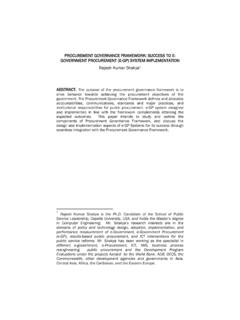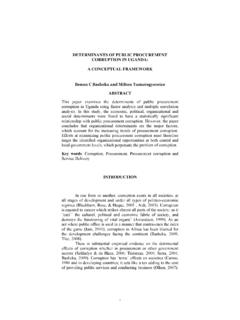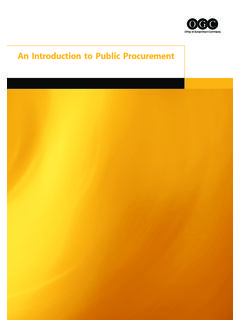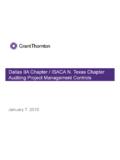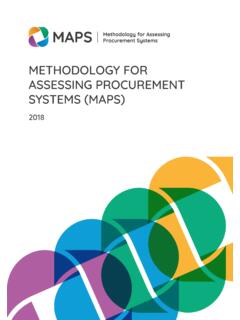Transcription of National Alliance Contracting Guidelines - Guide to ...
1 National Alliance Contracting GuidelinesGuide to Alliance ContractingSeptember 2015 National Alliance Contracting GuidelinesGuide to Alliance ContractingSeptember 2015 Document UpdatesThis Guide will be updated from time to time to reflect evolving best practices and lessons changeDateExposure Draft published by the Department of Treasury and Finance (Victoria) for comment 16 July 2010 Final version published by the Department of Treasury and Finance (Victoria)25 October 2010 National Guide published (with a refresh and update of the 25 October 2010 publication)July 2011 Updated in response to the Productivity Commission Report No 71 of May 2014 September 2015 Commonwealth of Australia 2015 ISBN 978-1-925216-66-0 September 2015/INFRA2602 Ownership of intellectual property rights in this publicationUnless otherwise noted, copyright (and any other intellectual property rights, if any) in this publication is owned by the Commonwealth of Australia (referred to below as the Commonwealth).
2 Disclaimer The material contained in this publication is made available on the understanding that the Commonwealth is not providing professional advice, and that users exercise their own skill and care with respect to its use, and seek independent advice if necessary. The Commonwealth makes no representations or warranties as to the contents or accuracy of the information contained in this publication. To the extent permitted by law, the Commonwealth disclaims liability to any person or organisation in respect of anything done, or omitted to be done, in reliance upon information contained in this Commons licenceWith the exception of (a) the Coat of Arms; (b) the Department of Infrastructure and Regional Development s photos and graphics, copyright in this publication is licensed under a Creative Commons Attribution Australia Commons Attribution Australia Licence is a standard form licence agreement that allows you to copy, communicate and adapt this publication provided that you attribute the work to the Commonwealth and abide by the other licence terms.
3 A summary of the licence terms is available from The full licence terms are available from This publication should be attributed in the following way: Commonwealth of Australia 2015, National Alliance Contracting Guidelines Guide to Alliance ContractingUse of the Coat of ArmsThe Department of the Prime Minister and Cabinet sets the terms under which the Coat of Arms is used. Please refer to the Department s Commonwealth Coat of Arms and Government Branding web page and in particular, the Commonwealth Coat of Arms Information and Guidelines usThis publication is available in PDF format. All other rights are reserved, including in relation to any Departmental logos or trade marks which may exist. For enquiries regarding the licence and any use of this publication, please contact:Director - Publishing and Communications, Communications Branch Department of Infrastructure and Regional Development GPO Box 594, Canberra ACT 2601 Australia Email: Website: in each jurisdiction will have their own individual approval processes for capital investment projects, as well as policies ( probity) and legislation that will impact on all capital works delivery.
4 These over-arching jurisdictional requirements are precedent to the Alliance practices covered in this Guidance Note is based on the guidance note of the same name prepared under the sponsorship of the Inter-Jurisdictional Alliancing Steering Committee with membership from: Department of Treasury and Finance, Victoria (Chair) Treasury, New South Wales Treasury, Queensland Department of Treasury and Finance, Western Australia Department of Infrastructure and Regional Development, Australian GovernmentThe production of the Guide was led by the Department of Treasury and Finance Victoria, with the assistance of Evans and Peck Pty Ltd, Level 2, 555 Coronation Drive Toowong, Queensland 4066 i CONTENTS Chapter 1: Introduction to the Guide .. 1 Purpose of the Guide .. 1 Who should use this Guide .
5 2 Structure of the Guide .. 3 How and when to use the Guide .. 4 Relationship with the Policy Principles for Alliance Contracting and Guidance Notes .. 5 Updates to the Guide .. 6 PART ONE: Overview of Alliance Contracting .. 7 Chapter 2: Introduction to alliancing .. 9 What is an Alliance ? .. 9 Differences between Alliance Contracting and traditional Contracting .. 24 Evolution of alliancing .. 25 Key roles in an Alliance .. 29 The value proposition: key benefits, risks and trade-offs of Alliance Contracting .. 31 Project alliancing and program alliancing .. 35 The fundamentals of Government Procurement .. 36 Chapter 3: Choosing alliancing as a delivery method .. 39 Projects most suited to alliancing .. 39 PART TWO: Overview of the development and implementation of Alliance contracts.
6 45 Chapter 4: Developing an Alliance project .. 47 Understand the commercial environment .. 48 Develop the Commercial Framework .. 49 The generic Commercial Framework .. 50 Changes to the Commercial Framework .. 61 Caps on Risk or Reward .. 61 Tailor a Commercial Framework to the Owner s project .. 63 Develop the PAA .. 65 Define and plan the Owner s resources .. 66 Specialist advisers .. 70 Delivery phase resources .. 74 Prepare resources for their roles .. 77 Best use of specialist advisers professional services .. 77 Guide to Alliance Contracting ii Chapter 5: Selecting the Non-Owner Participants .. 81 Alliance success dynamics .. 81 Tailoring the selection process .. 83 The tender selection criteria .. 84 Comparison of selection options .. 89 Other considerations.
7 94 Chapter 6: The Project Delivery Phase .. 99 Effective governance external and internal to the Alliance .. 100 Good project management and project controls .. 102 Expenditure of public funds .. 102 Adjustment Events .. 103 Rewarding outstanding outcomes .. 104 No blame, no 104 Progressive Status 105 Project close-out .. 105 Chapter 7: Learnings .. 107 Business Case Insights .. 107 Procurement Strategy Insights .. 108 Selecting the NOPs Insights .. 108 Agreeing the commercial arrangements Insights .. 109 Project delivery Insights .. 110 Chapter 8: Glossary and Acronyms .. 111 Glossary .. 111 Acronyms .. 113 Chapter 9: Bibliography .. 115 Appendices A. Developing a Governance Plan B. Developing a Governance Plan external to Alliance C.
8 NOP selection processes D. Commercial Framework Indicative Risk or Reward Regimes E. Risk or Reward for cost and non-cost performance: worked examples .Chapter 1 Introduction to the Guide 1 1 Chapter 1: Introduction to the Guide This Chapter outlines the purpose and structure of the Guide and describes the relationship of this document to other relevant government policy documents and Guidelines . Purpose of the Guide This Guide to Alliance Contracting ( the Guide ) has been prepared to provide consistent and leading practice guidance on Alliance Contracting to public sector agencies that develop and own infrastructure projects ( Owners ). This Guide reflects insights from government1 and industry which have been gained from significant experience over recent years, including $30 billion worth of public sector alliances that have either been completed or are currently being planned or implemented across Australia.
9 The Guide draws upon learning from the many projects, which are now complete, and were procured using Alliance Contracting , and upon the findings and recommendations set out in the report In Pursuit of Additional Benefits of alliancing Alliancing has evolved to become a broadly accepted procurement and delivery method, which has been used to successfully deliver many risky and complex projects. Under an Alliance contract, the Owner and the Non Owner Participants (NOPs) work together to collaboratively determine the best project solution and deliver the project. 1 Unless otherwise stated, the expression government is used to denote all the government entities of Australia, which include the Commonwealth of Australia and all Australian state governments and territories.
10 2 Released by the Department of Treasury and Finance, Victoria, Australia in October 2009. Guide to Alliance Contracting 2 The Guide has been prepared to: provide the minimum conditions for Owners in order to comply with the National Alliance Contracting : Policy Principles ( Policy )3 when delivering Alliance projects; provide guidance to public officials undertaking the planning and delivery of Alliance projects to enhance Value-for-Money (VfM) outcomes for governments; and improve the quality, consistency and commercial outcomes of government Alliance projects. This Guide has been developed recognising that Alliance Contracting : should comply with all relevant overarching jurisdictional policies and principles that generally regulate public sector procurement; is a complex commercial transaction and, accordingly, Owners should apply good commercial practices to the selection, development, procurement and implementation of Alliance contracts; and is now a mature procurement and delivery method for Owners, and has become a business-as-usual option for delivering infrastructure projects, , alliancing is no longer a pioneering, unique or novel approach to project delivery.

